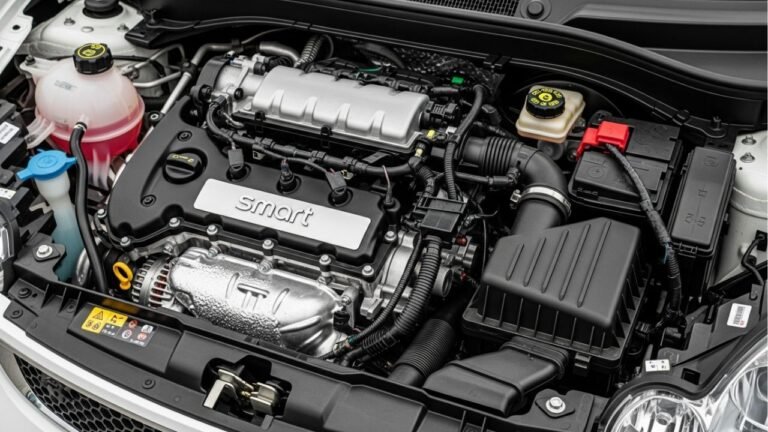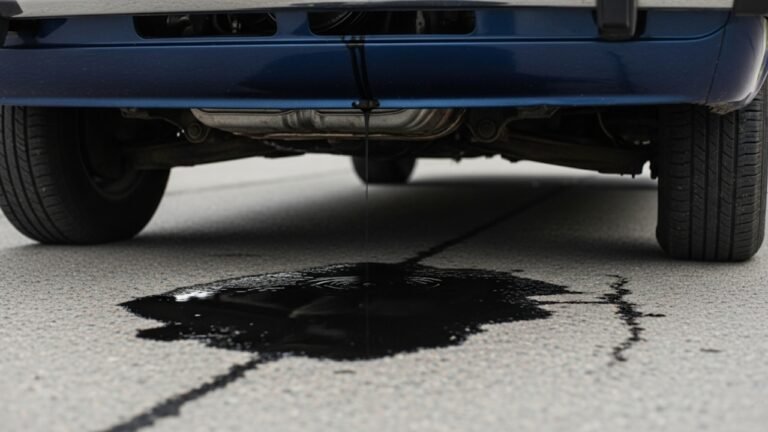What Happens If a Car Doesn’t Have Oil?

Imagine waking up one morning without blood running through your veins. You feel weak, dizzy, and eventually, everything shuts down. That’s exactly what happens to a car without oil.
Oil is the lifeblood of your engine. It keeps things moving smoothly inside, reduces friction, and stops your engine from overheating. Yet, many drivers ignore it until it’s too late.
I’ve had a friend, Rahim, who drove his car for two weeks ignoring that little red oil light. The result? A seized engine, a hefty repair bill, and a hard lesson learned. In this article, we’ll explore what happens if a car doesn’t have oil, how quickly things can go wrong, and how you can avoid making the same mistake.
Let’s dig into the gritty details that could save your engine—and your wallet.
In This Article
- 1 What Engine Oil Really Does (And Why It’s Non-Negotiable)
- 2 How Long Can a Car Run Without Oil?
- 3 Early Signs You’re Driving Without Oil
- 4 The Step-by-Step Breakdown of Damage
- 5 The True Cost of Driving Without Oil
- 6 Common Reasons Cars Run Out of Oil
- 7 Why This Mistake Happens More Than You Think
- 8 Quick Fix vs. Permanent Damage
- 9 How to Prevent Oil Loss in Your Car
- 10 Long-Term Effects of Driving Without Oil
- 11 A Personal Story: When I Almost Lost My Engine
- 12 FAQs About What Happens If a Car Doesn’t Have Oil
- 12.1 1. Can a car run with zero oil?
- 12.2 2. What are the warning signs of low or no oil?
- 12.3 3. What’s the cost of repairing an engine with oil starvation damage?
- 12.4 4. Can adding oil fix a damaged engine?
- 12.5 5. How often should I check my oil?
- 12.6 6. What kind of oil should I use?
- 12.7 7. Is synthetic oil better?
- 12.8 8. Is it okay to drive short distances without oil?
- 13 Final Thoughts: Your Engine Deserves Better
What Engine Oil Really Does (And Why It’s Non-Negotiable)
Think of your engine as a tightly packed machine with hundreds of metal parts grinding against each other at high speeds. Without oil, these parts would heat up, warp, and eventually break. Here’s what oil really does:
-
Lubricates moving parts to reduce wear
-
Cools the engine by dissipating heat
-
Cleans out impurities like dust and sludge
-
Seals gaps between the piston and cylinder walls
-
Protects metal parts from corrosion
When oil is missing, each of these roles collapses. That’s like asking someone to run a marathon barefoot over broken glass.
Without lubrication, engine components start grinding like sandpaper. Heat builds up. Metal parts expand unnaturally. And in minutes, your engine is on the road to self-destruction.
How Long Can a Car Run Without Oil?
Let’s get real—not long at all.
If a car is completely out of oil, the engine might last just 5 to 10 minutes before it starts sustaining serious damage. And in extreme cases, a total engine failure can happen in under a minute at high RPMs.
Here’s a rough breakdown of what might happen over time:
| Time Without Oil | What Happens |
|---|---|
| 0–1 minute | Friction increases, engine temperature spikes |
| 1–5 minutes | Parts start to grind, wear and tear begins |
| 5–10 minutes | Engine seizes, pistons may weld to cylinders |
| 10+ minutes | Total breakdown, full engine rebuild or replacement needed |
Even if you’re lucky and the engine doesn’t seize immediately, the long-term damage is irreversible. Tiny metal shavings from unlubricated parts can contaminate the entire system. Your oil pump, crankshaft, and camshaft will take a hit.
Early Signs You’re Driving Without Oil
Your car won’t scream, but it will whisper. If you’re paying attention, you’ll catch these early signs:
-
Oil warning light flickering or staying on
-
Burning smell from the engine bay
-
Loud ticking or knocking sounds from the engine
-
Rough idling or stalling
-
Overheating after short drives
-
Decreased fuel efficiency
I once ignored a soft ticking noise in my old Toyota. Thought it was just age. Turned out the oil was dangerously low, and the lifters weren’t getting enough lubrication. Luckily, I caught it in time and saved the engine. Others aren’t so lucky.
The Step-by-Step Breakdown of Damage
If you’re still wondering what happens if a car doesn’t have oil, here’s a stage-by-stage description of how your engine suffers:
1. Friction Builds Up Immediately
As soon as oil pressure drops to zero, metal-on-metal contact begins. Parts like the crankshaft and camshaft begin rubbing against bearings.
2. Overheating Starts Within Minutes
Oil not only lubricates but cools the engine. Without it, your car’s temperature skyrockets. Rubber seals and gaskets may melt or get damaged.
3. Piston Damage Sets In
The pistons move at insane speeds. Without oil, they can scrape against the cylinder walls, causing scoring, warping, and cracking.
4. Seizure Happens
Eventually, the engine parts expand from heat and friction until they can’t move anymore. That’s called a seized engine—and that’s a worst-case scenario.
The True Cost of Driving Without Oil
No one likes talking about money, but here it is: Engine repairs can cost more than your car’s worth. Here’s a quick overview:
| Damage Type | Estimated Repair Cost |
|---|---|
| Worn bearings | $500–$1,200 |
| Cracked pistons | $1,000–$3,000 |
| Seized engine | $4,000–$8,000+ (or total replacement) |
And it’s not just the engine. A dry engine can damage:
-
The oil pump
-
Turbochargers
-
Timing chain
-
Head gasket
-
And more…
This isn’t fear-mongering. It’s just mechanical reality. Think of oil as a $30 investment that could save you $7,000. Not bad, right?
Common Reasons Cars Run Out of Oil
Sometimes, it’s not your fault. But knowing why a car might be low on oil helps you prevent disaster.
-
Neglected oil changes
-
Oil leaks from seals or gaskets
-
Faulty oil pump
-
Burning oil due to worn piston rings
-
Improper oil levels after maintenance
Remember, you don’t need to be a mechanic to check your oil. Pop the hood. Pull the dipstick. Wipe it. Dip again. Check the level and color. That’s it.
Do this once every 2–3 weeks and you’ll likely never face engine failure due to no oil.
Why This Mistake Happens More Than You Think
You’d be surprised how many people don’t even know where the oil dipstick is. That’s not a jab—it’s just how little attention we give our cars. We expect them to work like magic.
But your engine is not magic. It’s metal, heat, combustion, and timing. Without oil, it loses all its balance.
A lot of newer drivers assume warning lights are “just suggestions.” That red oil can symbol? It’s a cry for help. Ignoring it can turn a $50 oil change into a $5,000 funeral.
Quick Fix vs. Permanent Damage
Some folks think, “I’ll just top up the oil later.” That works only if you catch it early. Once the damage starts, oil won’t undo it. Think of it like this:
Adding oil after the engine is damaged is like putting lotion on a sunburn after you’ve been in the sun for 10 hours. It helps a little—but the burn is already there.
If you hear a ticking sound, feel sluggish performance, or smell something burnt—stop the car and check the oil immediately. It might save you thousands.
How to Prevent Oil Loss in Your Car
If you’ve ever heard the saying “an ounce of prevention is worth a pound of cure,” this is where it really hits home.
Taking care of your engine oil is easier than most people think. You don’t need a mechanical degree—just a few basic habits.
Do These Regularly:
-
Check oil level every two weeks
Pop the hood and inspect your dipstick. It takes under two minutes. -
Get oil changes on time
Follow your manual—usually every 3,000 to 7,000 miles. -
Use the right oil type
Not all oils are equal. Some cars need synthetic, others don’t. Check the owner’s manual. -
Watch for leaks
If you see oil spots under your car or smell burning oil, get it checked ASAP. -
Listen to your engine
Ticking, knocking, or louder-than-usual operation could mean low oil pressure.
Bonus Tip: Keep a small bottle of engine oil in your trunk
Trust me—having it handy during emergencies can be a lifesaver, especially on long trips.
Long-Term Effects of Driving Without Oil
Let’s say you get lucky and your engine doesn’t seize. You still might face long-term engine degradation that creeps up like silent rust.
Over time, a car that’s been driven without proper oil will start showing:
-
Poor fuel economy
-
Slower acceleration
-
More frequent breakdowns
-
Higher emissions
-
Loss of compression
-
Corroded internal parts
And worst of all, your resale value drops significantly. When buyers or mechanics inspect your engine and find sludge, scarring, or oil starvation marks, they’ll either walk away or drastically reduce their offer.
A Personal Story: When I Almost Lost My Engine
A few years back, I took a road trip to the Sundarbans. It was hot, the road was long, and I was pushing the car hard. Midway through the highway stretch, the oil light came on.
I thought, “I’ll check it when I get there.”
Big mistake.
The engine started stalling at 90 km/h. Smoke started rising. I pulled over just in time. The mechanic found I had almost no oil left, thanks to a leaky oil pan. Another 15 minutes of driving and I would’ve needed a full rebuild.
That trip cost me emotional stress, a tow truck bill, and four hours in the heat. But it could’ve been much worse.
FAQs About What Happens If a Car Doesn’t Have Oil
1. Can a car run with zero oil?
No. A car cannot function properly without oil. It will overheat, seize, and break down within minutes.
2. What are the warning signs of low or no oil?
Look out for the oil warning light, burning smells, strange engine noises, and reduced performance.
3. What’s the cost of repairing an engine with oil starvation damage?
Repairs can range from $500 for minor parts to $8,000+ for full replacements.
4. Can adding oil fix a damaged engine?
Not always. If the engine is already damaged, fresh oil can’t reverse the wear.
5. How often should I check my oil?
Every 2-3 weeks is ideal. Check it more frequently if you drive long distances or have an older car.
6. What kind of oil should I use?
Use the manufacturer-recommended oil—usually found in your owner’s manual. Using the wrong one can cause damage.
7. Is synthetic oil better?
It often is. Synthetic oil resists heat better, lasts longer, and flows more smoothly, especially in modern engines.
8. Is it okay to drive short distances without oil?
No. Even driving a short distance can start damaging the engine. Don’t risk it.
Final Thoughts: Your Engine Deserves Better
Look, life gets busy. It’s easy to forget things like oil changes. But ignoring your engine’s need for oil is like starving your body of water. You won’t feel it immediately—but when it hits, it hits hard.
The question “what happens if a car doesn’t have oil” might sound simple, but the answer is complicated, costly, and sometimes heartbreaking.
The good news? This entire problem is 100% preventable. With a little love, a few minutes of maintenance, and some basic awareness, you can avoid engine disasters and keep your car happy for years.
Just like you wouldn’t run a marathon without water—don’t expect your car to take you places without oil.






